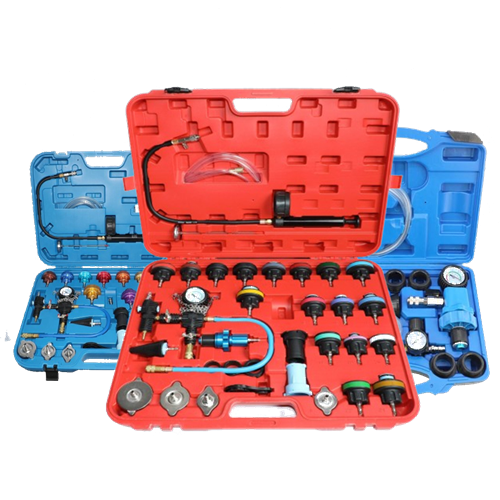Cooling System Maintenance Tool Usage Guide: Keeping Your Engine Running Smoothly
Time: 2024-11-12
The cooling system is a critical component of any vehicle, responsible for regulating engine temperature and preventing overheating. Proper maintenance of this system is essential for ensuring optimal engine performance and longevity. This article will provide a comprehensive guide to the tools used in cooling system maintenance, detailing their applications and best practices to keep your engine running smoothly.

Essential Cooling System Maintenance Tools
1. Coolant Pressure Tester
-
Description: A coolant pressure tester is used to check for leaks in the cooling system by pressurizing the system and measuring its ability to hold pressure.
-
Application: This tool helps to identify issues such as leaking hoses, bad gaskets, or cracked radiators. By detecting leaks early, you can prevent more significant engine problems.
2. Radiator Flush Kit
-
Description: A radiator flush kit allows for the cleaning of the radiator and cooling system to remove built-up debris, rust, and contaminants.
-
Application: Regular flushing of the cooling system helps maintain efficient heat transfer and prevents overheating. This kit typically includes a container and hoses for introducing cleaning solutions into the system.
3. Thermostat Test Kit
-
Description: A thermostat test kit is used to evaluate the performance of the thermostat, ensuring it opens and closes at the correct temperatures.
-
Application: Testing the thermostat can help identify if it is stuck open or closed, both of which can lead to engine temperature issues. A properly functioning thermostat is crucial for maintaining optimal engine temperature.
4. Infrared Thermometer
-
Description: An infrared thermometer measures the surface temperature of the engine and cooling components without direct contact.
-
Application: This tool is invaluable for diagnosing cooling system problems. By measuring temperatures at various points, technicians can identify hotspots that indicate cooling inefficiencies or failures.
5. Engine Cooling System Pressure Tester
-
Description: This tool is used to check the integrity of the cooling system return circuits and determine if the water pump and radiator cap are functioning correctly.
-
Application: By applying pressure to the system, you can reveal leaks or weaknesses that may affect cooling efficiency. This is essential for ensuring the entire system is working correctly.
Best Practices for Using Cooling System Maintenance Tools
Follow Manufacturer Instructions: Always refer to the specific instructions provided by the tool manufacturer for optimal usage and settings. Improper use can lead to inaccurate readings or damage to components.
Perform Regular Inspections: Regularly check the cooling system components as part of routine vehicle maintenance. Early detection of issues can save time and costs in the long run.
Wear Proper Safety Gear: When working with the cooling system, especially when pressure testing or handling coolant, wear appropriate safety gear such as gloves and goggles to protect against spills and splashes.
Ensure Cleanliness: Keep all tools and the work area clean. Contaminants can affect the performance of the cooling system and lead to further issues.
Use High-Quality Coolants and Additives: When replacing coolant, always select the recommended types for your vehicle. High-quality coolants can prevent corrosion and scale buildup within the cooling system.
Conclusion
Maintaining the cooling system is essential for keeping your engine operating at the ideal temperature. By utilizing the right tools, such as coolant pressure testers, radiator flush kits, and infrared thermometers, you can ensure that your vehicle’s cooling system functions efficiently. Following best practices and regularly checking the cooling components will help prevent overheating and extend the life of your engine. Invest in high-quality tools and prioritize cooling system maintenance to keep your engine running smoothly for years to come.

